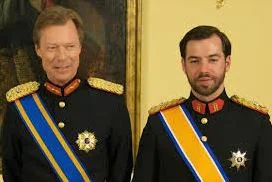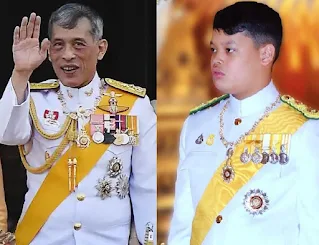For general knowledge purposes, below is the list of heir-apparent and heir-presumptive of the monarchies around the world, categorized by continent.
In Europe, we can immediately tell who is the heir-apparent or heir-presumptive of the reigning sovereign, however, in some parts of the world, especially in the Middle East, heir-apparent is determined by appointment of the monarch or election by the Throne Council, and not automatically bestowed to the eldest son.
Countries with Heir-Apparent
ASIA
1. Bahrain - An Asian country located in the Middle East. It is situated on the Persian Gulf and officially known as Kingdom of Bahrain.
It's a semi-constitutional monarchy headed by the king. Its current ruler is Hamad bin Isa bin Salman Al Khalifa, 72, and is ruling since 2002. His heir-apparent is his eldest son, Salman bin Hamad Al Khalifa (born on October 21, 1969), who is also one of the Prime Ministers of the country, and its Supreme Commander of the Defense Force.
2. Bhutan - The Kingdom of Bhutan is a landlocked country in the Eastern Himalayas, located between China and India. It is the only country in the world that is zero carbon emission or carbon-negative, according to GVI UK. It is a mountainous country and is 70% covered with trees.
 |
| King Jigme, his two sons, and wife, Queen Jetsun ©Queen Jetsun Pema instagram |
Bhutan has changed its government from absolute monarchy to constitutional monarchy. Its current monarch is King Jigme Khesar Namgyel Wangchuk, reigning since 2008. His heir-apparent is his eldest son, Jigme Namgyel Wangchuk, born on February 5, 2016. He is only six years old as of 2022. He is the youngest heir-apparent in the world today. Ruling family: House of Wangchuk
3. Brunei - Officially known as Brunei Darussalam, it is an oil-rich, tiny kingdom in Southeast Asia. The country maintains an absolute monarchy. Brunei has a parliament but there are no elections.
Under Brunei's 1959 constitution, His Majesty, Hassanal Bolkiah is the head of state with full executive authority. He also serves as Brunei's prime minister, finance minister and defense minister. His heir-apparent is his eldest son, Al Muhtadee Billah, born on February 17, 1974.
4. Jordan - Officially the Hashemite Kingdom of Jordan. Just like most monarchies in the Middle East, Jordan is a unitary state with a semi-constitutional monarchy form of government. The current monarch is King Abdullah II, reigning since 1999. He retains wide executive powers from the government and parliament.
When King Abdullah II ascended the throne in 1999 upon the death of his father, King Hussein, the appointed heir-apparent was his younger half-brother, Prince Hamzah, said to be the favorite son of King Hussein.
In 2004, he removed Hamzah as Crown Prince and appointed his eldest son, Prince Hussein, as the new heir-apparent. The title Crown Prince was officially conferred on Prince Hussein in 2009. He was born on June 28, 1994. Ruling family: House of Hashemite
5. Kuwait - officially the state of Kuwait, it is one of the smallest nations in the world in terms of land area. It is located on the north-east corner of the Arabian peninsula. It follows a unitary parliamentary and semi-constitutional monarchy form of government.
Kuwait's current monarch, called Emir, is Nawaf Al-Ahmad Al-Jaber Al-Sabah. Despite having sons, his heir-apparent is his half-brother, Mishal Al-Ahmad Al-Jaber Al-Sabah, who at 81, is the oldest heir-apparent in the world. An heir-apparent in Kuwait is determined through a nomination by the Emir and must be voted in the parliament.
Kuwait is following the Agnatic seniority succession, it is a patrilineal order of succession where the monarch's younger brother precedes the monarch's own sons in the line of succession. A monarch's children can only succeed after the males of the elder generation have all been exhausted.
6. Oman - officially the Sultanate of Oman, it is a country in the Middle East. The country follows an absolute monarchy form of government where the Sultan is the head of state and directly controls the executive, legislative and judiciary functions. He has an absolute power and issues laws by decree.
The current Sultan of Oman is Haitham bin Tariq and the heir-apparent is his eldest son, Theyazin bin Haitham Al Said, born on August 21, 1990.
7. Saudi Arabia - officially the Kingdom of Saudi Arabia. It is a country in the Middle East. It is an absolute monarchy where the king controls the executive, legislative, and judicial functions of the state. The king is also the prime minister of the country.
The current monarch of Saudi Arabia is King Salman bin Abdulaziz, and his heir-apparent is his 7th son, Mohammed bin Salman born on August 31, 1985.
8. Tonga - officially the Kingdom of Tonga, it is a country located in the Oceania near New Zealand. It is one of the smallest nations in the world with just a total area of 289 square miles. However, despite its small size, they have well developed sports programs, regularly sending delegates to the Summer and Winter Olympics. Tonga's national Rugby Team performed well in the Rugby World Cups.
It became a constitutional monarchy in 2010 and its current monarch is Tupou IV since 2012 (but was crowned only in 2015). His heir-apparent is his eldest son, Tupoutoʻa ʻUlukalala, born on September 17, 1985.
8. United Arab Emirates - also called the Emirates, it is a country in the Middle East, and is composed of seven emirates, known historically as the Trucial States. Each emirate is governed by an Emir, and together formed the Federal Supreme Council, and elect among its members the President and Vice President of UAE.
In practice, the emir of Abu Dhabi (the capital of UAE) serves as the country's president while the emir of Dubai (largest city in UAE) serves as the Vice President and Prime Minister.
UAE's current president is Mohamed bin Zayed Al Nahyan (ruler of Abu Dhabi) and the VP/Prime Minister is Mohammed bin Rashid Al Maktoum (ruler of Dubai). Al Maktoum was involved in a bitter custody battle of his children with his estranged wife, Princess Haya, the half-sister of King Abdullah II of Jordan, in the British court.
UAE's heir-apparent in every emirate:
- Ajman - Sheikh Ammar bin Humaid bin Rashid Al Nuaimi (eldest son of the current emir)
- Dubai - Sheikh Hamdan bim Mohammed Al Maktoum (second son of Rashid Al Maktoum)
- Fujairah - Sheikh Mohammed bin Hamad bin Mohammed Al Sharqi (eldest son of the current emir)
- Ras Al-Khaimah - Sheikh Mohammed bin Saud Al Qasimi (eldest son of the current emir)
- Sharjah - Sheikh Sultan bin Muhammad bin Sultan Al Qasimi (cousin of the current emir)
- Umm Al-Quwain - Sheikh Rashid bin Saud bin Rashid Al Mualla (son of the current emir)
AFRICA
1. Lesotho - officially the Kingdom of Lesotho, it is a landlocked country enclaved by South Africa. Lesotho was a former British colony and declared its independence from the United Kingdom in 1966.
It is a constitutional monarchy, and its current monarch is Letsie III. The heir-apparent is his only son, Lerotholi Seeiso, who was born on April 18, 2007.
2. Morocco - The Kingdom of Morocco is a westernmost region in north Africa. It is considered a semi-monarchy form of government but the 2011 constitutional reform limits the power of the king.
EUROPE
All 10 reigning royal houses in Europe today follow the constitutional monarchy/parliamentary democracy form of government.
1. Belgium (Kingdom) - The current monarch of Belgium is King Philippe. He ascended the Belgian throne on July 21, 2013 upon the abdication of his father, King Albert II of Belgium, for health reasons.
 |
| Princess Elisabeth and her father, King Philippe©Zimbio |
King Philippe's heir-apparent is his eldest child, Princess Elisabeth, the Duchess of Brabant. She was born on October 25, 2001. Belgium's first monarch was Leopold I, maternal uncle of Queen Victoria of the United Kingdom and paternal uncle of her husband, Prince Albert. Ruling family: House of Belgium/Saxe-Coburg and Gotha.
2. Denmark (Kingdom) - The current monarch of Denmark is Queen Margrethe II, reigning since January 14, 1972. Her heir-apparent is her eldest son, Crown Prince Frederik born on May 26, 1968. Ruling family: House of Glucksburg.
3. Liechtenstein (Principality) - The current Sovereign Prince of Liechtenstein is Hans Adam II since November 13, 1989. His heir-apparent is his eldest son, Prince Alois, the Hereditary Prince and Count of Rietberg.
The Princely House of Liechtenstein follows an agnatic succession where the throne can only be passed to male descendants. In 2004, the United Nations committee questioned this succession law which tends to discriminate women.
Prince Hans Adam II responded in 2007 on why the law cannot be changed to male-preference or absolute primogeniture succession law. "The succession law is older than the Principality of Liechtenstein itself. It is a family tradition that does not affect the country's citizens", further emphasizing that the Constitution of Liechtenstein stipulates that succession to the throne is a private family matter.
4. Luxembourg (Grand Duchy) - Luxembourg is the only remaining grand duchy in the world. It is one of the smallest countries in the world but one of the wealthiest in terms of GDP per capita. It has more than 600,000 population as of 2021 data.
 |
| Grand Duke Henri and his heir-apparent, Prince Guillaume ©Getty |
The succession law of Luxembourg was altered on June 20, 2011 to Absolute Primogeniture law. The current Grand Duke of Luxembourg is Henri, He ascended the Luxembourgian throne on October 7, 2000, upon the abdication of his father, Grand Duke Jean who died in 2019. His heir-apparent is his eldest son, Prince Guillaume, the Hereditary Grand Duke. who was born on November 11, 1981. Ruling family: House of Luxembourg-Nassau.
5. Monaco (Principality) - Monaco still follows the male-preference primogeniture law where males precede females in the line of succession. The Sovereign Prince of Monaco is Prince Albert II since April 2005 on the death of his father, Prince Rainier III.
 |
| Prince Albert II and Hereditary Prince Jacques ©The Prince's Palace |
His heir-apparent is his only legitimate son, Hereditary Prince Jacques born on December 10, 2014. Prince Jacques has a twin sister, Princess Gabriella, who was born minutes ahead of him. Ruling family: House of Grimaldi
6. Netherlands (Kingdom) - The Kingdom of the Netherlands consists of four constituent countries: Netherlands, Aruba (South America), Curaçao (South America), Sint Maarten (North America), and the Caribbean islands: Bonaire, Sint Eustatius, and Saba.
 |
| Princess Amalia and her father, King Willem-Alexander ©RVD-Patrick van Emst |
7. Norway (Kingdom) - a Nordic country in Northern Europe. Norway officially separated from Sweden and became an independent monarchy on June 7, 1905. The Norwegian throne was offered to Prince Carl of Denmark, grandson of Christian IX of Denmark.
He reigned under the name, Haakon VII. His wife was his first cousin, Princess Maud of Wales, the youngest daughter of King Edward VII of the United Kingdom and Queen Alexandra (daughter of Christian IX).
The current monarch of Norway is King Harald V, grandson of Haakon VII and Queen Maud. His heir-apparent is his second child and only son, Crown Prince Haakon, born on July 20, 1973.
Although Norway altered its succession law to Absolute Primogeniture in 1990, it was not done retroactively, thus, Crown Prince Haakon, still precedes his older sister, Princess Martha Louise, in the line of succession. Ruling family: House of Glucksburg
8. Sweden (Kingdom) - The reigning monarch of Sweden is King Carl XVI Gustaf since 1973. Sweden's succession law was altered into Absolute succession and took effect on January 1, 1980.
Unlike other countries, the changes were applied retroactively, displacing the king's only son, Prince Carl Philip, by an older sister, now Crown Princess Victoria, Duchess of Vastergotland, who was born on July 17, 1977. Ruling family: House of Bernadotte.
9. United Kingdom - The reigning monarch of the United Kingdom and Her Realms is Queen Elizabeth II since February 6, 1952. She is the second longest-reigning monarch in world history, and at 96, the oldest living monarch and Head of State in the world today.
 |
| Prince Charles and Queen Elizabeth II. Getty Images |
Her heir-apparent is Charles, the Prince of Wales. At 73, he is the second oldest heir-apparent in the world after the Crown Prince of Kuwait. In Scotland, he is known as the Duke of Rothesay. He has two other duke titles. Duke of Cornwall (since February 1952), and Duke of Edinburgh (since April 9, 2021). He is also called the Prince Steward of Scotland.
Apart from the United Kingdom, Prince Charles is also heir-apparent to these territories where the British monarch is the head of state: Antigua and Barbuda, Australia, Bahamas, Belize, Canada, Grenada, Jamaica, New Zealand, Papua New Guinea, St. Helena island, Saint Kitts and Nevis, Saint Lucia, Saint Vincent and the Grenadines, Solomon Islands, and Tuvalu. Ruling family: House of Windsor
Countries and Territories without Heir-Apparent
1. Cambodia - officially Kingdom of Cambodia, is a country in Southeast Asia. King Norodom Sihamoni has no heir-apparent nor heir-presumptive because the next monarch in Cambodia is determined through election by the Throne Council.
2. Eswatini - a landlocked country in Africa formerly known as Swaziland. Its current monarch is King Mswati III and his successor is determined through election.
3. Japan - a country in East Asia. Japan still maintains the agnatic succession law where females are barred from succeeding the throne. The reigning emperor of Japan is Naruhito since 2019. He and Empress Masako have an only child, Princess Aiko, but ineligible to succeed. The emperor's heir-presumptive is his younger brother, Prince Fumihito, Crown Prince Akishino.
Japan's Diet (parliament) attempted to change the succession law in 2005, to allow Princess Aiko to succeed her father, however, Prince Fumihito's wife gave birth to a son in 2006, Prince Hisahito, thereby terminating the plan of changing the succession law.
4. Malaysia - a country in Southeast Asia. A new monarch is determined through election.
5. Qatar - officially the state of Qatar, a country in the Middle East. The current Emir of Qatar is Tamim bin Hamad Al Thani. The order of succession of Qatar is determined by appointments within the House of Al Thani.
6. Spain - A country in southwestern Europe. King Juan Carlos abdicated the throne on June 19, 2014, in favor of his only son, now King Felipe VI of Spain. Felipe has no sons, thus, the heir-presumptive is his eldest daughter, Leonor, Princess of Asturias, born on October 31, 2005.
There was an attempt to change the succession law of Spain in 2006, but when Letizia, the Princess of Asturias, gave birth to another daughter, Infanta Sofia, in 2007, the plan halted because Princess Leonor's position in the line of succession is unthreatened. Ruling family: House of Bourbon.
7. Thailand - The Kingdom of Thailand is located in Southeast Asia. It is a constitutional monarchy and the succession is hereditary. However, to become an heir-apparent, the monarch should declare the successor as Crown Prince. The current Thai monarch, King Vajiralongkorn (reigning since 2016), has yet to declare his heir-apparent.
He has five sons, but a son who will most likely to succeed him is his youngest son, Dipangkorn Rasmijoti, born on April 29, 2005. He is considered the king's heir-presumptive because the four older sons were disowned by the king when he divorced their mother.
Why Dipangkorn is only heir-presumptive? It's because his father divorced his mother in 2014, thus his position in the line of succession is uncertain. The king has still other four older sons who are recognized by Thailand's succession law as legitimate claimants to the throne. Ruling family: House of Mahidol of the Chakri dynasty.
8. UAE Abu Dhabi - The emir of Abu Dhabi has yet to appoint his heir-apparent. Although he has sons who are eligible to succeed him, just like all monarchies in the Middle East, an heir-apparent must be officially declared first by the monarch. The recognized heir-presumptive is his eldest son, Khalid bin Mohamed bin Zayed Al Nahyan. Ruling family: House of Al Nahyan.
9. Vatican - an independent city state within Rome, Italy. It is headed by the Roman Pontiff known as the Pope. It is considered an elective monarchy, where the Pope reigned until his death. But the pope can abdicate or resign if he wishes to, just like what Pope Benedict XVI did in 2013, for health reasons.
The succession is determined by election through Conclave, where Princes of the Universal Church, known as Cardinals, gather in the Sistine Chapel to elect the next Roman Pontiff.

























0 Comments